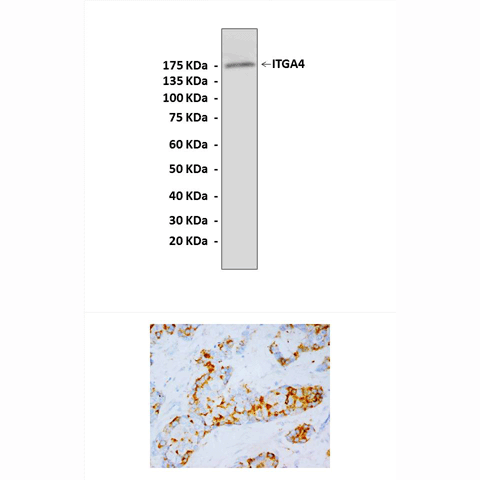Anti-ITGA4: Rabbit Integrin alpha 4 Antibody |
 |
BACKGROUND The Integrins are a family of alpha/betab heterodimeric receptors that mediate dynamic linkages between extracellular adhesion molecules and the intracellular actin cytoskeleton. Integrins are expressed by all multicellular animals, but their diversity varies widely among species; for example, in mammals, 19 alpha and 8 beta subunit genes encode polypeptides that combine to form 25 different receptors. Both Integrin subunits are type I transmembrane proteins with large extracellular and short cytoplasmic domains of 700-1100 and 30-50 residues respectively. Integrins are ubiquitously expressed and at physiological conditions, Integrins are highly glycosylated and contain a Ca2+ or Mg2+ ion, which is essential for ligand binding. Integrin receptors are critical for cell attachment to the extracellular matrix (ECM) and this is mediated through integrin-fibronectin, -vitronectin, -collagen and -laminin interactions. Intracellularly, Integrins form adhesion complexes with proteins including talin, vinculin, paxillin and alpha-actinin. They also regulate kinases, such as focal adhesion kinase and Src family kinases, to mediate attachment to the actin cytoskeleton. Integrins also have a significant role in cell signaling and can activate protein kinases involved in the regulation of cell growth, division, survival, differentiation, migration and apoptosis. The beta 1, beta 3, and beta 5 Integrin intracellular domains are sufficient to initiate signal transduction pathways. Furthermore, alternative splicing can regulate the ability of beta integrin intracellular domains to participate in signal transduction. Glycoprotein II/IIIb (alphaIIb/beta3) is an integrin receptor found on the surface of platelets. It is involved in the cross-linking of platelets with fibrin, and so has a vital role in blood clot formation.1
The integrins alpha4/CD49d (alpha4beta1 and alpha4beta7) are heterodimer cell adhesion receptors mainly expressed on cells of hematopoietic origin that mediate cell–cell and cell–extracellular matrix interactions. Vascular cell adhesion molecule-1 (VCAM-1) and the alternatively spliced connecting segment-1 (CS-1) region of fibronectin constitute ligands for both integrins, whereas alpha4beta7 can additionally interact with mucosal addressin cell adhesion molecule-1. alpha4beta1 and alpha4beta7 play key roles in leukocyte recruitment to inflammatory sites and in lymphocyte recirculation, and alpha4beta1 function is required during hematopoiesis in the bone marrow.2 A characteristic feature of alpha4 integrins on most leukocytes is that their adhesive activity can be up-regulated by external stimuli, leading to firm attachment. Several chemokines binding to their G protein-coupled receptors, as well as cytokines whose receptors have tyrosine kinase activity have been previously demonstrated to rapidly and transiently increase alpha4 integrin-dependent cell adhesion. For instance, the chemokine stromal cell-derived factor-1alpha (SDF-1alpha) up-regulates alpha4 integrin-mediated lymphocyte, hematopoietic progenitor, and myeloma cell adhesion.3 The enhancement in adhesion was shown to be independent of changes in alpha4 surface expression and was suggested to be the result of variations in the avidity and/or affinity of these integrins for their ligands. In addition, TGF-beta1 can potentially contribute to cell migration by dynamically regulating cell adhesion mediated by alpha4 integrins.4
The integrins alpha4/CD49d (alpha4beta1 and alpha4beta7) are heterodimer cell adhesion receptors mainly expressed on cells of hematopoietic origin that mediate cell–cell and cell–extracellular matrix interactions. Vascular cell adhesion molecule-1 (VCAM-1) and the alternatively spliced connecting segment-1 (CS-1) region of fibronectin constitute ligands for both integrins, whereas alpha4beta7 can additionally interact with mucosal addressin cell adhesion molecule-1. alpha4beta1 and alpha4beta7 play key roles in leukocyte recruitment to inflammatory sites and in lymphocyte recirculation, and alpha4beta1 function is required during hematopoiesis in the bone marrow.2 A characteristic feature of alpha4 integrins on most leukocytes is that their adhesive activity can be up-regulated by external stimuli, leading to firm attachment. Several chemokines binding to their G protein-coupled receptors, as well as cytokines whose receptors have tyrosine kinase activity have been previously demonstrated to rapidly and transiently increase alpha4 integrin-dependent cell adhesion. For instance, the chemokine stromal cell-derived factor-1alpha (SDF-1alpha) up-regulates alpha4 integrin-mediated lymphocyte, hematopoietic progenitor, and myeloma cell adhesion.3 The enhancement in adhesion was shown to be independent of changes in alpha4 surface expression and was suggested to be the result of variations in the avidity and/or affinity of these integrins for their ligands. In addition, TGF-beta1 can potentially contribute to cell migration by dynamically regulating cell adhesion mediated by alpha4 integrins.4
REFERENCES
1. Schwartz, M.A. & Ginsberg, M.H.: et al: Nature Cell Biol. 4:E65-E68, 2002
2. Lobb, R.R. & Hemler, M.E.: J. Clin. Invest. . 94:1722–8, 1994
3. Postigo, A.A. et al: Res Immunol. 144:723-35, 1993
4. Bartolomé, R.A. et al: Mol. Biol. Cell 14:54-66, 2003
2. Lobb, R.R. & Hemler, M.E.: J. Clin. Invest. . 94:1722–8, 1994
3. Postigo, A.A. et al: Res Immunol. 144:723-35, 1993
4. Bartolomé, R.A. et al: Mol. Biol. Cell 14:54-66, 2003
Products are for research use only. They are not intended for human, animal, or diagnostic applications.
Параметры
Cat.No.: | CA1046 |
Antigen: | Short peptide from human ITGA4 sequence. |
Isotype: | Rabbit IgG |
Species & predicted species cross- reactivity ( ): | Human, Rat |
Applications & Suggested starting dilutions:* | WB 1:1000 IP n/d IHC 1:50 - 1:200 ICC n/d FACS n/d |
Predicted Molecular Weight of protein: | 176 kDa |
Specificity/Sensitivity: | Detects endogenous levels of ITGA4 proteins without cross-reactivity with other related proteins. |
Storage: | Store at -20°C, 4°C for frequent use. Avoid repeated freeze-thaw cycles. |
*Optimal working dilutions must be determined by end user.
Документы
Информация представлена исключительно в ознакомительных целях и ни при каких условиях не является публичной офертой








